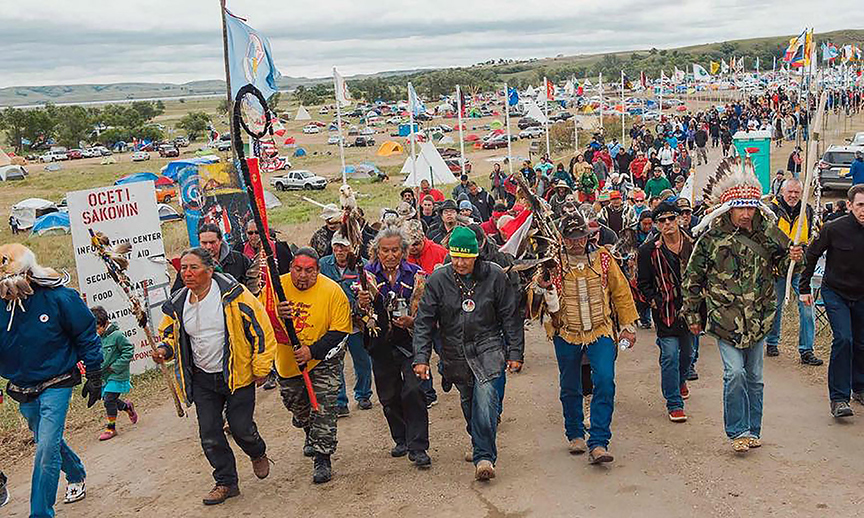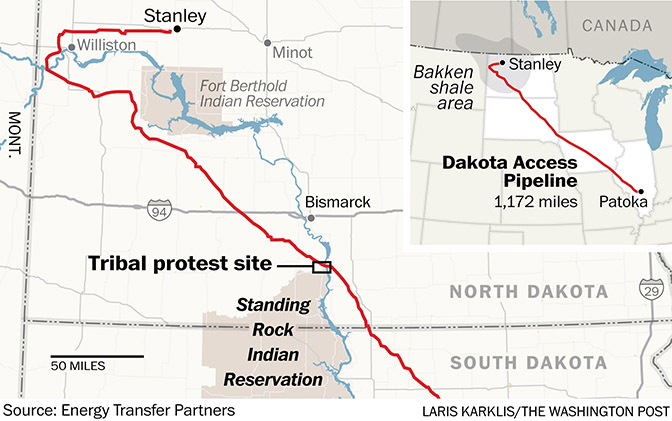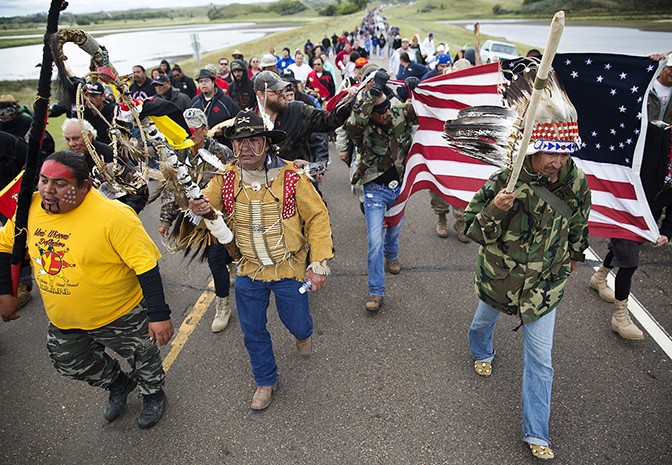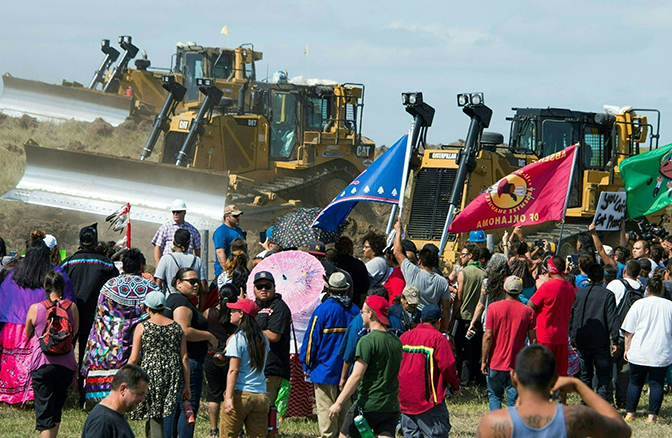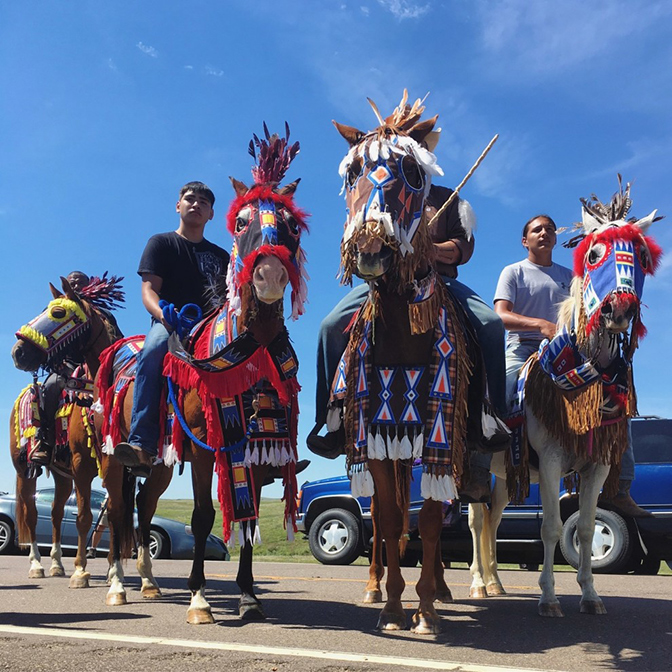Water Is Life: Pipelines, Vermonters & Standing Rock |
|||||||||
| by K.C. Whiteley | |||||||||
|
|
||||||||
Lakota Sioux and their allies march along Flag Road at the Oceti Sakowin camp.
|
|||||||||
Over 2.5 million miles of gas and oil pipelines crisscross the U.S. and Canada, like the labyrinth of arteries in our circulatory system, an intricate and interconnected maze. More than half of the nation’s pipelines are at least 50 years old. Inevitably, they will leak and spill. Plans for the $3.8-billion Dakota Access Pipeline began in 2014, when Bakken oil field production was peaking at about 900,000 barrels of oil a day. Constructed by Energy Transfer Partners (ETP), the pipeline proposes to transport about 470,000 barrels of oil a day, running 1,172 miles from the North Dakota oil fields through South Dakota, Iowa, and Illinois to a terminal in Patoka, Illinois, where the crude oil will be loaded onto railroad cars and connect to an existing pipeline. It crosses hundreds of waterways, disturbs sacred tribal sites and burial grounds, and twice crosses under the Missouri River, which the Lakota people depend on for their water. Another 17 million people downstream also depend on this for their water supply. More than two-dozen major banks and financial institutions are financing the construction, including Toronto Dominion (TD), Bank of America, Goldman Sachs, JP Morgan Chase, and Wells Fargo. Together, they have extended a $3.75 billion credit line to ETP, the parent company of Dakota Access. Donald Trump owns shares in ETP.
|
|||||||||
|
|||||||||
|
Resistance to the relentless build-out of fossil fuel infrastructures is growing but requires massive volunteer efforts to fight a well-financed corporate and political system that profits from fossil fuel extraction. One place stands out today as the focal point of resistance: The Standing Rock Sioux Reservation, located at the confluence of the Cannonball and Missouri Rivers in North Dakota, has become the unifying center and front line of the fight to stop what native people refer to as the “black snake.” In April, LaDonna Brave Bull Allard, a member of the Standing Rock Sioux tribe, founded the first resistance camp, Sacred Stone, on her land, near Fort Yates, North Dakota. When notice came in July that pipeline construction would begin, Allard put out a call to indigenous people to come join the Sioux at Sacred Stone. What began as a small encampment of just three people has grown to become the largest gathering of native North American tribes—approximately 300—and their allies in history. By August two more camps had joined Allard’s: Rosebud, a spirit camp, and a large and rapidly growing site across the Cannonball River called Oceti Sakowin, or Seven Council Fires, so named for the seven bands of the Sioux. Kitchens sprang up, receiving massive amounts of donated food and offering daily meals to hundreds, sometimes thousands. Medical tents were established, and volunteer health-care providers arrived. Scores of Vermonters have traveled to Oceti Sakowin. Over the summer a camp infrastructure evolved guided by the tribal elders and indigenous youth leaders to ensure that nonindigenous allies would be introduced to and included in the traditional ways. Daily meetings are held to orient newcomers to the mission of this nonviolent protest, which identifies the people as water protectors, not protestors. Camp rules forbid weapons or the use of drugs and alcohol. All actions are guided by nonviolent civil disobedience principles and nonviolent direct action (NVDA).
Unless you are a Facebook user or learned about Standing Rock through alternative news networks, there was no mainstream media attention about what was happening there, particularly to the extreme militarized response to a peaceful and prayerful resistance. Then, in September, Amy Goodman of Democracy Now arrived and covered a violent police response, which included dogs attacking the water protectors. The live newscast went viral and shocked people around the world with its pointed visual reminders of 1960’s police brutality against civil rights activists in the Deep South. Today, North Dakota has earned the sad but well-deserved title of the Deep North for its embedded racial bigotry directed at Native Americans. At last, Standing Rock had come into public view. By October, Oceti Sakowin had mushroomed into a small city, with estimates of close to 10,000 at times. Well-known celebrities showed up to lend support: Mark Ruffalo, Shailene Woodley, Neil Young, Joan Baez, Robert Kennedy Jr., and Patricia Arquette built 100 compost toilets. Dave Mathews, Bonnie Raitt, and Jackson Brown donated concert proceeds. To find out for myself what was so different and engaging about this peaceful action, I traveled to Standing Rock in November with my colleague Arthur Hynes from the 350VT board. A videographer and photographer, this was Hyne’s third visit. We left Vermont in the early morning hours on Election Day and drove 2,000 miles. My first sight of the beautiful sprawling Oceti Sakowin camp with teepees pointing to the sky was a heart-stopping experience. After declaring ourselves as allies at the entrance, we drove down what is called Flag Road, past the sacred fire, with the sound of hundreds of tribal flags and banners snapping in the ever-present sweep of wind across the plains. Young people on horseback rode through camp, clusters of tents and camper vans staked out the borders of new roads, and the sweet scent of wood smoke and sage floated on the air. Drumming and singing could be heard in the background, often at the sacred fire, lit for the first time since June 25, 1876, by the seven council fires of the Lakota Nation. We picked a spot to pitch our tents and were greeted by nearby neighbors: two women who had carpooled from Florida in a colorful old VW van, a young musician from Alabama, and David, a native Haida elder and military vet from Ketchikan, Alaska, who had put his van on a boat to Seattle and then driven to North Dakota. A career mechanic, he spent his days, and often nights, repairing vehicles at camp, pro bono. I had no trouble finding ways to contribute—from staining the seats of 100 composting toilets being cranked out, using solar-powered saws and drills, to replace the chemical-filled Portalets, to sorting and organizing donated medical supplies coming in daily, to lending a hand to a neighbor putting up his tent. Hynes, like all good observers and recorders of people and events, looks at how things fit together and finds the visuals that reveal the heart of a gathering. To communicate the visceral experience of being at Standing Rock, Hynes has published one video, Standing with the Water Protectors (https://Vimeo.com/188824552), and is working on another. Hynes, like many others who have gone to Standing Rock, pointed out that nonnative allies need to step back, listen, and “check our egos.” At the same time, he observed that there was “a profoundly human struggle that came out in many ways—misconceptions, uncertainties, mixed messages. All our relationship challenges are still there. What we can do here is work on that.” Part of that challenge is to reach out and build bridges with our own native brothers and sisters here in Vermont.
Since I’ve returned, I’ve met and talked to dozens of Vermonters who made the trek to Standing Rock and returned invigorated and awakened to a new spirit of community. Beverly Little Thunder, a lifelong activist and pipe carrier and resident of Huntington, Vermont, is an enrolled member of the Standing Rock Sioux band. For 14 years, Little Thunder and her partner have offered sweat lodges and healing ceremonies for women through their organization, Kunsi Keya. She spent time at Oceti Sakowin’s Two Spirit camp in October, her first time to be welcomed back into the community as a Two Spirit elder. “Standing Rock seems to have been the catalyst for healing in a lot of different areas, a unifying space where [my partner and I] were recognized and respected and could stand alongside of people who may have shunned us 20 years ago,” she said, referring to her difficulties with the tribe when she came out as a lesbian. Little Thunder identifies much of the homophobia in indigenous communities as a by-product of Christianity, not based in the traditional culture. For Little Thunder, going back was an emotional homecoming. Before coming out, she had been chosen to receive her pipe from an elder woman. Being a pipe carrier means you are carrying medicine and become a servant of the people. “It is a huge responsibility to my community and my people. You can’t buy a pipe. There are specific things you need to do to awaken that power. The pipe gains power from the people who smoke it. It doesn’t belong to me. I caretake it.” Little Thunder talked about native traditions that are showing activists the value and effect of prayerful action. She said they pray for the police, pray for the pipeline workers, and ask “for them to see what we are seeing; the destruction of the land and water and wildlife.” She stressed the importance of NVDA trainings to ensure everyone understands that what the protectors are doing is a sacred action taken to protect the next seven generations and Mother Earth. It is about enlarging the circle to include people who might appear to be enemies.
Patti Garbeck resides in Woodbury, makes her living as a carpenter and teacher at Yestermorrow Design Build School. She was in the midst of a big job when she got the call to join a builders brigade leaving in three days from central Vermont. “I had two days to prepare. I cranked the job, packed, and headed out with the caravan.” Garbeck describes herself as a doer, not an activist who marches or writes letters: “I went there to build, not to be in protest.” Organized by climate activists based in Plainfield, Vermont, 45 builders, half from Vermont, signed on for the journey. They loaded six woodstoves, tools, and building materials into a 26-foot box truck and headed west, the same day as a busload organized by 350Vermont left Burlington. They all arrived at Oceti Sakowin the evening of the now-infamous assault Sunday night, November 20, on the Highway 1806 Backwater Bridge. On the bridge in freezing temperatures, peaceful water protectors were sprayed by police in full riot gear with high-pressure water hoses and tear gas and pelted with rubber bullets and compression grenades. A frightening reception. Ivan Shadis, from Montpelier, was also part of the builders brigade. Upon arrival at Standing Rock, he filled out a legal form for people risking arrest and signed on with a buddy to go to the front line. He describes the scene at Backwater Bridge as “nightmarish.” The first day the builders plugged right into an organized build. Shadis, who worked on construction and winterizing projects, said he found the camp to be well organized and easy to contribute to. Garbeck was also impressed with the way people worked together, a different experience for someone used to working with carpenters who often have their preferred ways of building. “I always tell my students, you ask eight carpenters the same question, and you get eight different answers and ways to do it. At Standing Rock, everyone was there to work for the cause; people listened to one another and worked without egos.” The first night camping in a summer tent, “it was freezing, so cold we couldn’t sleep.” The next morning, Henry Harris, one of the organizers, gave her and two others brand-new sleeping bags rated to 10 degrees. Tired and cold from a long day working outside, she climbed into her tent to try out the new sleeping bag. “There was a knot and I couldn’t open the bag. It was so frustrating. I finally got it undone and a note was there in the top of the bag. ‘Dear fellow American, thank you so much for being there and helping the water protectors and caring for the earth.’ I just cried reading it and realized that’s why they put a knot in it, to keep the note inside. All three of our bags had the notes.” When they left, they donated the bags back to camp. Garbeck stuffed the note back in the bag for the next person.
Todd Clason arrived at Standing Rock the same day as Garbeck, on the 350 bus from Burlington. He admits to feeling some anxiety about the unknown situation they would be entering. Stepping off the bus “I was struck by the amazing beauty of the place, people everywhere, amazing dwellings. Amazement is a good antidote to anxiety. Your heart and eyes and ears get filled with sights and impressions.” The viciousness of the police action at the bridge that night quickly changed that impression. Over the next several days, Clason got a better understanding about how the camp was organized and operated. “They ask you to pay attention and step back before doing anything, to absorb and watch and listen, which is great advice. There are many opportunities to help and lots to do.” Clason noted that tasks our culture doesn’t value—like food prep, cleanup, childcare—were appreciated and valued. Like others, Clason was impressed with the respect for elders, the commitment to nonviolent principles, the spirituality underlying daily activities and ever-present reminders of shared purpose, and the deep connection to the land and water. “Every day we’re praying for the water. It’s the constant drumbeat there.” He recalls a personal experience spotlighting the commitment to nonviolence. Clason was part of an action helping to paddle people out to an island in the river. The police, wearing body armor and carrying assault rifles, deliberately tried to provoke them. He began to respond in anger and yelled back at the police taunts. Instantly, an elder said, “We’re not here to be angry or hateful. We’re here to pray for the water.” Clason felt immediately released from that anger and able to get back to being helpful. “To see nonviolence function in action is powerful. The way you behave is so important.” Returning from Standing Rock, Clason cites the important lessons from his time at Standing Rock as a renewed commitment to community, “to helping people feel the power that they have and how useful they are. We may not be able to stop things from happening but we have to bond together to stand in resistance to what we’re morally opposed to.”
|
|||||||||
|
K.C. Whiteley is an environmental activist and 350VT board member.
|
||||||||

